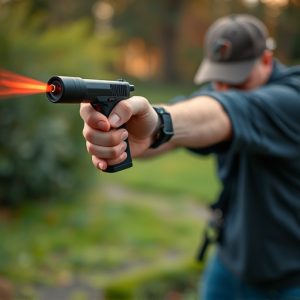Mastering Pepper Spray Equipment: Distance, Training, and Legal Insights
The effective use of defensive pepper spray is governed by legal regulations dictating distance (2-1…….
The effective use of defensive pepper spray is governed by legal regulations dictating distance (2-10 meters) for deployment, ensuring a balance between public safety and individual rights. Its active ingredient, capsaicin, disrupts vital bodily functions, primarily targeting the eyes, nose, and respiratory system. With a typical range of 30 feet, it's a non-lethal tool enabling officers to disable or deter suspects from a safe distance. Choosing the right equipment involves considering factors like distance range (6-12 meters), potency, carrier type, ease of use, and proper training for deployment and maintenance. Specialized training is required to understand DPS active ingredients, effects, and appropriate usage scenarios, mastering the defensive pepper spray distance range for strategic and responsible deployment.
“In modern law enforcement, effective control tools are essential for managing volatile situations. One such tool, defensive pepper spray, has sparked significant interest due to its potential impact on public safety. This article explores the legal framework surrounding defensive pepper spray, delving into its scientific effectiveness and the crucial factors of equipment selection, training, and safety protocols. Understanding the optimal deployment distance and range can significantly enhance officer safety and crowd control capabilities.”
- Understanding Pepper Spray: A Legal Perspective
- The Science Behind Pepper Spray's Effectiveness
- Choosing the Right Equipment: Factors to Consider
- Training and Safety Measures for Effective Deployment
Understanding Pepper Spray: A Legal Perspective
Pepper spray, officially known as oleoresin capsicum (OC) spray, is a non-lethal law enforcement tool designed to incapacitate and control suspects temporarily. From a legal standpoint, its use is governed by specific regulations and guidelines that vary across jurisdictions. Understanding these parameters is crucial for both law enforcement agencies and individuals looking to acquire defensive pepper spray for personal protection.
The defensive pepper spray distance range is a critical aspect of this discussion. Laws typically dictate the permitted distance from which an officer can deploy pepper spray, often ranging from 2 to 10 meters (6.5 to 32.8 feet), depending on local regulations. This distance ensures that officers can effectively disable a threat while minimizing harm and potential over-usage. The legal framework also outlines circumstances under which pepper spray is permissible, such as during an arrest, to prevent escape or to control aggressive behavior, ensuring a balanced approach to public safety and individual rights.
The Science Behind Pepper Spray's Effectiveness
The effectiveness of pepper spray, also known as oleoresin capsicum (OC) spray, lies in its ability to disrupt normal bodily functions when deployed. This law enforcement equipment works by targeting the eyes, nose, and respiratory system, causing temporary but intense discomfort. The active ingredient, capsaicin, is derived from chili peppers and is highly irritant. When sprayed, it binds to pain receptors, leading to a burning sensation and reduced visibility, making it an effective tool for crowd control and self-defense.
The defensive pepper spray distance range varies depending on the brand and model, but typically, it can be effective up to 30 feet (around 9 meters). This range allows officers to disable or deter suspects from a safe distance while minimizing collateral damage. The scientific precision behind pepper spray ensures that it remains non-lethal, providing an essential tool for law enforcement in high-risk situations.
Choosing the Right Equipment: Factors to Consider
When choosing the right pepper spray equipment for law enforcement, several factors come into play. One of the most critical considerations is the defensive pepper spray distance range. Officers need to select a spray that allows them to maintain a safe distance from potential threats while still ensuring maximum effectiveness. The optimal range varies based on the specific needs of different operations and environments, but typically falls between 20 to 40 feet (6 to 12 meters). This range ensures officers can deploy the spray safely without risking injury to themselves or bystanders.
Other essential factors include the spray’s potency, carrier type, and ease of use. Potency refers to the concentration of capsaicin, the active ingredient in pepper spray, which determines its effectiveness. Carrier types, such as aerosol or gel, affect the spray pattern, dispersion, and retention time. Ease of use is paramount; officers need equipment that can be deployed quickly and reliably under stressful conditions. Additionally, training on proper usage and maintenance is crucial to ensure the equipment remains functional when needed most.
Training and Safety Measures for Effective Deployment
Law enforcement officers require comprehensive training to effectively utilize defensive pepper spray, ensuring it is deployed safely and strategically. Training programs should cover the principles of non-lethal force, including understanding the defensive pepper spray’s active ingredients, effects, and recommended usage scenarios. Officers must learn the appropriate defensive pepper spray distance range, knowing when and how to deploy it while minimizing risk to bystanders and themselves.
Safety measures are paramount during training and regular practice sessions. This includes simulating various situations, such as crowd control or close-quarters encounters, to familiarize officers with precise application techniques. Regular training also enables them to recognize potential risks and adverse effects, ensuring they can de-escalate situations effectively and responsibly.
Law enforcement pepper spray equipment plays a vital role in modern policing, offering a tactical tool with both a defensive and disruptive capability. By understanding its legal perspective, recognizing its scientific effectiveness, and selecting the right gear, officers can ensure safe and strategic deployment. Training is paramount to maximize its impact within recommended defensive pepper spray distance ranges, fostering public safety while mitigating risks associated with its use.


